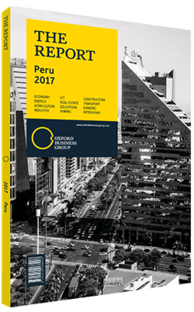Lowering transport costs could help unlock Peru's economic potential
According to the National Society of Industries ( Sociedad Nacional de Industrias, SNI), residents of Lima take some 17m trips a day via the city’s public transport system, double the figure 15 years ago. Local citizen rights group Lima Cómo Vamos reported in September 2016 that 25% of the city’s population spend over two hours a day getting to their destination, while nearly half say that public transport is the biggest problem in the capital. Only the residents of Colombia’s notoriously congested capital of Bogotá spend more time getting about, with an average of 97 minutes per trip, according to data from public transit app Moovit. In contrast, average travel times in the Chilean capital of Santiago are 35% less than that in Lima, according to the CAF – Development Bank of Latin America.
Cost Burden
This widespread traffic issue is not just a headache for commuters. Lima is now the city with the second-highest logistics costs in Latin America. By way of illustration, domestic transport costs in Peru make up 43% of total logistical cost, higher than the regional average of 32%, according to SNI. This is also significantly higher than in Chile, Brazil and Mexico, where the proportion is 12%, and far off the average in developed countries such as the US or Germany, where domestic transport is 8% and 9% of logistics costs, respectively. Lima Cómo Vamos also found that 75.6% of Limeños use public transport, of which the majority use buses or microbuses known as combis.
However, the SNI has pointed out that this situation is an opportunity to improve competitiveness. The institute calculated that if Peru had the same logistical costs as Chile, the country could save $2bn a year. In a similar vein, the Inter-American Development Bank estimates that shaving one percentage point off domestic transport costs could boost exports by at least 4%. At the 21st International Forum of Logistics and Supply Chains in October 2016 Carlos Niezen, founder and partner of consultancy firm Activas Partners, said in Peru logistics costs are 12.6% of GDP on average, although they rise to 16.4% in agriculture, 15.1% in oil and mining and 13.1% in construction. These costs also differ quite a lot by geographical zone as well, ranging from 13% in coastal areas, to as high as 23% in the mountainous zones and a substantially higher 31% in the Amazon jungle. These costs in the Amazon and Andes act as heavy penalties, if not an outright disincentive, for investment. Peru also lacks a supply cold chain to connect ports with the interior of the country. However, there are fiscal exonerations in place in the Amazon and the Andean highlands for imported products for consumption.
Investment Returns
The return on invested capital in the country is 8% on average, according to Activas Partners. Niezen estimated that a mere one percent reduction in logistics costs could lift the return on invested capital across several sectors, increasing it from 13.4% to 14.9% in the manufacturing sector and from 0.4% to 1% in the oil and mining sector, for example. Increasing the return on invested capital could make the country more attractive to investors.
Speaking to OBG in February 2017, Sergio Mazuré Cordero, general manager of the Cargo Business Group, noted that there are growing costs associated with having a central focus on Lima and Callao and relying so much on these two areas as a transport and storage hub for the whole of the country. Outside of efforts to expand the port of Callao and improve the road network in and around the Lima-Callao Metropolitan Area, Cordero suggested that other locations must be given more serious attention, and investment, as complimentary hubs. He cited the project for a port in Pisco, 280 km south of Callao, as one with obvious potential. The current Port of San Martín has a 700-metre pier with four mooring docks. However, state investment agency ProInversión is looking to repair the first and second berths and is planning to offer a tender. The more than $100m works would include dredging a 14-metre, multipurpose dock, a yard for bulk cargo, two mobile cranes and support facilities.
You have reached the limit of premium articles you can view for free.
Choose from the options below to purchase print or digital editions of our Reports. You can also purchase a website subscription giving you unlimited access to all of our Reports online for 12 months.
If you have already purchased this Report or have a website subscription, please login to continue.

